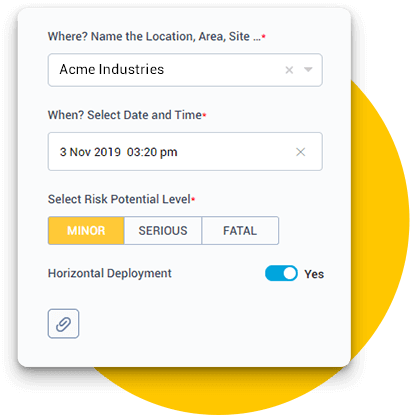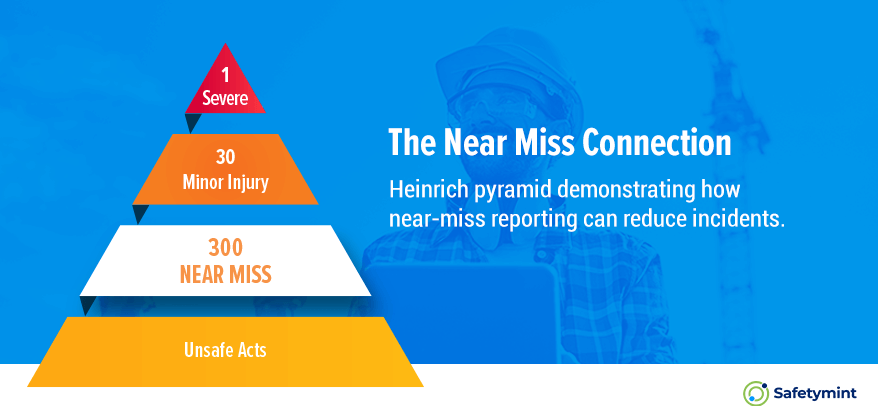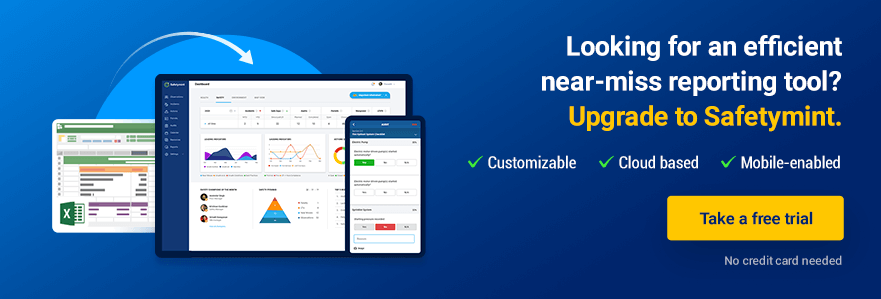What is Near Miss Reporting?
Near miss reporting is a safe work procedure that aims to eliminate potential incidents by ensuring that close-calls or near accidents are proactively reported to facilitate swift actions that prevent its reoccurrence. Near miss reporting systems reinforces an organization’s safety culture – promoting active participation in reporting close-calls, enables early interventions and provides leading indicators to reduce workplace fatalities.

Watch Safetymint in action
What is a Near Miss Event?
A near-miss is defined by OSHA as an unplanned event that does not result in injury, illness, or damage – but had the potential to do so.
Near-miss is essentially a non-accident that due to a fortunate break in the chain of events caused no damage or injury to human life and property. Near misses is a result of unsafe acts caused by human errors and unsafe conditions from faulty processes or systems.
To demonstrate how incident management can reduce minor and fatal incidents, Herbert Heinrich, a safety and health pioneer, devised the prominent accident prevention theory known as the “Safety Triangle” or “Heinrich’s Triangle”. According to Heinrich, for every fatal accident, there are approximately 300 unsafe acts that are reported as near-misses – indicating that reporting near misses can lower the frequency of unsafe acts while drastically reducing the chance of severe-injuries or fatalities.
Why is near miss reporting so important?
Simply put, without a near miss reporting software system, the learning begins only when an accident occurs and there is severe loss or injury to human life and property.
The notion of reporting close-calls when there’s no damage done seems a futile effort, especially if the odds keep falling in our favor and there are no legal obligations to do so.
Yet, history has shown that almost every catastrophic disaster is a result of overlooking near-miss warnings that preceded the event.
Accidents that are barely avoided have become commonplace in the modern workplace. With so much to do and so little time, employees often cut corners and perform unsafe activities to stay ahead. Every fortunate encounter with a near miss goes unnoticed or unreported and is often shared casually. Even reporting near-misses or following up on its progress is avoided as it takes time off the task at hand. While some avoid reporting unsafe acts by their fellow employees as it may lead to chastisement, fear of being blamed or even disciplinary action for reporting.
Writing off a near miss as “no harm no foul” can prove detrimental in the long run. At some point the chain breaks and the luck finally run out, leading to a catastrophic event that gets everyone’s undivided attention to a prevailing hazard.
Near miss reporting is the only recognized incident management structure that accurately identifies and reports near misses, effectively communicates risk tolerance measures to employees, eradicates the root cause of the hazard and prevents future accidents or injuries from taking place.
Goals of a near miss reporting software:
- Establish a reporting culture where every near-miss incident is accurately reported.
- Understand the circumstances that lead to the hazard to determine root cause.
- Plan and implement preventive action to immediately contain the incident.
- Rethink the safety process and build strategies to prevent its reoccurrence.
- Establish a training and open communication module that creates near miss awareness.
What are the causes of near misses?
Thought accidents are impervious to time and space, identifying the core root of an underlying anomaly helps us understand the origins of a hazard and form preventive actions to contain its escalation. Some of the most common causes of near miss events are:
- Unsafe conditions
- Unsafe work practices
- Unsafe procedures
- Human error
- Lack of training
- Lack of safety awareness
- Employees that cut corners
- Lack of communication
- Unsafe tools
- No standardized procedure to report near misses
Near miss reporting procedures:
To instill a strong reporting culture among employees, organizations must strive to build and communicate a set of near miss reporting guidelines that one should follow when they witness a near miss. They are:
- Report the near miss incident, no matter how small or who it happens to.
- Make sure the scene of the incident is secured as fast as possible
- Communicate the incident to supervisors and the safety department
- Fill out a near miss report with the exact details of the incident.
- Follow up and actively participate in investigative procedures
- Ensure that fellow employees are aware of the hazard.

How to improve near miss reporting?
Ease the reporting culture:
Provide employees with a system that is easy to use, understand and communicate reports instantly to concerned personnel.
Fill reports effortlessly:
Empower employees to fill incident details in reports accurately without generating additional work.
Anonymous reporting:
Report at-risk behavior of close aides without disclosing your identity to avoid the fear of being blamed.
Generate curiosity:
To encourage proactive participation, employees need to know all the specifics of the importance of near miss reporting systems and how to use it.
Holistic Participation:
Active engagement from the managerial team can have a ripple effect to encourage employees to prioritize reporting safety incidents.
Swift hazard resolutions:
Set rapid action teams to investigate and resolve incidents with minimal loss to work-time.
Learn from data:
Analyze trends and record new findings to integrate into other safety systems like behavior-based system (BBS) to check incident prone tendencies.
Encourage open communication:
Highlight recorded hazards and lessons learnt during toolbox talks, bulletin boards, employee orientation programs, etc – creating awareness across your enterprise.
Examples of near miss reporting
Determining what constitutes a near miss scenario is easy. Be it any industry, look for incidents or behavioral patterns in which actions that could have led to severe consequences but did not lead to its logical conclusion due to a fortunate turn of events, can be classified as a near miss. Some common near miss scenarios include:
- Non-injury caused due to falling from heights including stairs, Mobile elevated work platforms (MEWA), rooftops and more
- Slippery conditions that could have led to slips or trips that cause serious injuries or dislocations.
- Working on machinery without proper Lockout or Tagout procedures (LOTO).
- Working without proper Personal Protective Equipment (PPE) like helmets, gloves, etc.
- Risky or negligent behavior in several scenarios like driving heavy machinery above the prescribed speed limit.
- Close shave caused due to improper training or maintenance of machinery.
- Evading the path of a falling object
- Near miss caused due to improper or no signage which could lead employees to enter otherwise restricted zones without isolations)
Near miss reporting forms
A near miss report form should consist of a detailed record of the near miss incident with the time and location. It should easily and accurately convey the underlying danger to safety officials to mitigate risk and prevent accidents from happening.
A near miss reporting form should ideally contain:
- The date and time in which the near miss event took place
- Pinpoint the exact location with the Site name, site division, and site unit.
- Give an accurate account of the description of the event explaining the hazard, people involved and witnesses.
- Provide a severity rating based on your industry’s endorsed EHS risk matrix.
Near miss reporting – FAQs
Is near miss a legal requirement?
There a no specific statutory laws under the health and safety legislation that specify that undertaking near miss investigations in a necessity. Yet, if an unaddressed safety hazard leads to a catastrophic event, the company can get penalized for failing to identify and eliminate the hazard.
Why is it called a near miss?
A near miss or close call refers to a scenario that should have resulted in an accident but didn't - causing no injury or loss. Near miss reporting provides an early opportunity to fix a prevailing hazard before it results in a catastrophic incident.
Is near miss an incident?
Yes, near misses can be considered as an incident. OSHA states "near misses as an incident" with no property damage or personal injury, but given a slight shift in time or position, could have easily caused damage or injury.
What is the difference between a near miss and a hazard?
A hazard is a physical or environmental factor that can or has the potential to cause harm. A near miss is an unplanned event in which a hazard with the potential to compromise safety, but for a fortuitous turn of events, left no injury or loss.
What are the steps for near miss investigation?
Some of the key steps to conducting a near-miss investigation are:
- Collect information from every source and witness.
- Ascertain the information gathered and establish facts.
- Explore the cause-and-effect relationship to establish the root cause.
- Eliminate hazard and reoccurrences by taking corrective and preventive actions.
SaaS-based Near Miss Reporting Software
Safetymint is the definitive safety management software suite that can efficiently manage and reduce incidents by reporting near misses instantly and remotely, analyze and negate at-risk behavioral trends, and ensure continuous compliance under evolving safety regulations.
Empower your team with a robust and proactive safety management software that can shoulder all your rear miss reporting needs in a unified, easy-to-use, and universally accessible system – keeping people at the heart of safety.

Advantages of Safetymint's digitized near miss software:
- Get started right away by creating your free trial account
- All-in-one safety system with incident, audit and permit management
- Intuitive interface that requires minimal training to get on board
- Connect employees from all sites in a unified environment
- Create near miss reports on the spot using your mobile device
- Customize incident reporting forms according to your requirement
- Cloud-based SaaS EHS software that is accessible from anywhere, at any time.
- Instant data sharing system that ensures quick approvals and reviews.
- Create investigative teams, analyze root cause and set CAPA measures
- Analyze trends and behavioral patterns to align with the best HSE practices.
- Attach documents and take photos of the incident.
- Get a complete overview of all activities from report creation to resolution.


